© 2014-


Radio England - History
A lavish press conference in London on 20th April 1966 announced the launch of yet another offshore radio project -
The new project planned to start broadcasts from off the Essex coast by the end of April, but in fact test transmissions for the two new stations -
Although based on the same  ship the twin stations were to be radically different from eachother and from any other offshore or landbased stations then on the air. Radio England, which planned to compete in the market area already covered by Radios Caroline, London and City, was to be a brash, all-
ship the twin stations were to be radically different from eachother and from any other offshore or landbased stations then on the air. Radio England, which planned to compete in the market area already covered by Radios Caroline, London and City, was to be a brash, all-
Behind this ambitious project were some of the original backers of Radio London - o London early in 1965 after fundamental boardroom differences over that station's programming style and format. Money was to be no object!
o London early in 1965 after fundamental boardroom differences over that station's programming style and format. Money was to be no object! 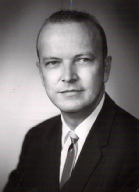
A management company was formed for the new project -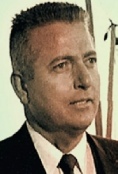 hich quickly led to financial problems for both Radio England and Britain Radio.
hich quickly led to financial problems for both Radio England and Britain Radio.
At the beginning of 1966 the project’s ship Olga Patricia (later re-
However, shortly after the ship sailed from Miami the aerial mast collapsed and there then followed a series of delays and a display of gross inefficiency in dealing with problem. The Olga Patricia spent two weeks in Lisbon then Continental Electronics suggested that the ship should sail to her proposed anchorage off the British coast and the work would be carried out at sea. The vessel sailed for her anchorage off Harwich and lay silently at anchor while Continental Electronics arranged to bring equipment from Dallas and from West Germany to rebuild the aerial system.
Test broadcasts eventually started from the ship on 3rd May. To begin with Radio England broadcast on 355m (845kHz) although the potential transmitter power of 55Kw was not achieved due to technical problems. For most of May 1966 test broadcasts continued sporadically with regular interruptions and breakdowns while the equipment was adjusted and modified.
On 3rd June 1966 the Italian Government complained that the transmissions from Radio England were interfering with its Roma 2 station and as a result Radio England swapped frequencies with its sister station, Britain Radio, while transmitter power was reduced significantly during the evenings. The Italian Government also complained to Panama about interference from the two stations on board the Laissez Faire. As a result the Laissez Faire's registration was withdrawn and the vessel remained a stateless ship for two months until she was re-
Regular programmes from Radio England eventually started on 16th June 1966 on a wavelength of 225m (announced as 227m) (133kHz).
Programming on Radio England (or Swinging Radio England as it was more usually known) was something entirely new to British audiences. It was undiluted and unashamedly American in style with fast talking DJs, known as "Boss Jocks", making much use of technical gimmicks such as echo and reverberat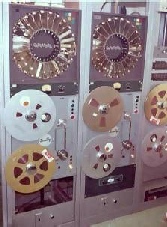 ion units, as well as an automated Carousel unit -
ion units, as well as an automated Carousel unit -
This unit, similar in principle to a juke box, but working with tape cartridges instead of discs, could be used to provide either non-
Before coming over to England to launch their twin offshore station project in the spring of 1966 Vick, Pierson and Curtis hired a number of DJs from American Top 40 stations, mainly in Georgia. To supplement this nucleus of American broadcasting staff they also recruited some English DJs and deliberately engaged staff who had little or no previous radio experience in the hope that the US DJs would be able to influence them in the style of presentation required on the stations.,The adoption of this policy was later to lead to a serious conflict between the two groups, helping to undermine the success of the whole project and in particular, Radio England.

Radio England testing on 355m, May 1966


Click on picture to enlarge
Don Pierson
The automated Carousel unit

The Times
21st May 1966
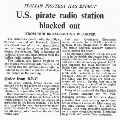
The Times
7th June 1966
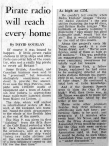
The Guardian
21st April 1966
Solid Gold Sunday promo

Joint Radio England/Britain Radio test transmission on 355m, June 1966

History
Key Dates
Ship and Location
Technical
Staff
Programmes







These a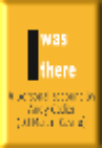 re the only tape machines I have seen that could play in both directions. Certainly a heavily mechanised machine to achieve constant unattended programming. The rotation of the carousel cartridge player was far from quiet and could be used on demand (remote control) or in sequence with the three tape machines. A spool of male vocals, female vocals and instrumentals was normal, each track being back-
re the only tape machines I have seen that could play in both directions. Certainly a heavily mechanised machine to achieve constant unattended programming. The rotation of the carousel cartridge player was far from quiet and could be used on demand (remote control) or in sequence with the three tape machines. A spool of male vocals, female vocals and instrumentals was normal, each track being back-
Great memories.
Tom Dannaher
Bill Vick
Treasure Chest


Daily Mail
3rd June 1966

Miami News
1st April 1966
Courtesy Mike Barraclough




Back to Britain Gallery


Back to Radio England
